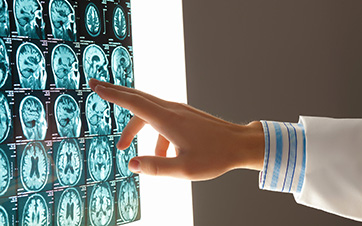
The relative survival rate for all patients with a malignant brain tumor is 36%; approximately 18,000 Americans died as a result of a malignant brain tumor last year. Thankfully, people have a less than 1% chance of developing a malignant brain tumor in their lifetime, according to the American Cancer Society.
Brain cancer occurs as a result of cancerous cell growth in the brain. Depending on the type of tumor, the cancer cells form tumors that are either slow-growing or fast-growing. There are many different types of brain cancer and in this blog post, we will highlight some of the different types you should be aware of.
We will also highlight the common symptoms of brain cancer, the causes and risk factors, and the different treatment options that are available. Let's get started.
Different Types of Brain Cancer
There are more than 120 different types of brain tumors, cysts, and lesions. Here is a breakdown of some of the most common as well as serious types of brain cancer.
Glioma
Gliomas are a type of brain tumor that originates in the glial cells. In total, they account for around 33% of brain cancer cases. While they originate in the brain, they may also be found in the spinal cord.
Given that there are many different types of glial cells, there are also many types of gliomas. These include glioblastomas, a particularly aggressive tumor type, oligodendrogliomas, and astrocytomas.
In the case of astrocytomas, one common form is pilocytic astrocytoma. This is a benign brain tumor that is usually found in children and young adults.
Meningioma
A typically benign brain tumor, meningiomas originate in the meninges, which refer to the outer layers of tissue that cover and protect the brain. It is more common for women to be diagnosed with meningiomas than men.
The majority of meningiomas (85%) are slow-growing and noncancerous tumors. If left undiscovered, meningiomas can be life-threatening and severely disabling given that they can grow very large. Some meningiomas are also very persistent and may come back even after treatment.
Craniopharyngiomas
Craniopharyngiomas are benign tumors that grow near the pituitary gland. They may appear as either cysts or solid tumors and often press on parts of the brain, blood vessels, or nerves around the pituitary gland.
They can result in vision difficulties, given that they can press on optic nerves. These tumors most commonly affect children and teenagers as well as adults over 50 years of age.
Schwannomas
Another brain tumor that is almost always benign is schwannomas. Also known as acoustic neuromas, they are slow-growing that form around the cranial nerves. Only around 8% of primary brain tumors are schwannomas.
Common symptoms of a schwannoma include muscle weakness, numbness, a visible lump under the skin, aching or burning pain, and a pins-and-needles sensation. While malignant schwannomas do exist, they are very rare and typically appear in the upper arms, lower back, and legs.
Medulloblastoma
This is the most common form of malignant brain tumor found in children, typically affecting children between the ages of 5 and 9 years. This type of brain tumor arises in the cerebellum, which is located at the base of the skull.
Medulloblastoma, though generally rare, is most common in families that have a history of conditions that increase the risk of cancer, such as Turcot syndrome or Gorlin syndrome. Treatment of medulloblastoma typically includes surgery and chemotherapy and/or radiation.
Chordoma
This is a rare form of bone cancer (less than 1% of primary brain tumors are diagnosed as chordomas). Only around 300 people in the United States are diagnosed with this condition each year. It is usually found in either the base of the skull or the lower back.
The symptoms of chordoma cancer vary depending on the location and the size of the tumor. Though they grow slowly, they can become large and push on parts of the brain. Possible symptoms include:
- Vision problems
- Pain in the head, neck, and face
- Paralysis of facial nerves
- Trouble swallowing
- Numbness and tingling
- Vomiting
Chordoma cancer may metastasize to other parts of the body, including the lungs, liver, and lymph nodes.
Lymphoma
Lymphomas may form in the brain or spread to the brain from other body parts. The two overarching categories of lymphoma are Hodgkin’s lymphoma and non-Hodgkin’s lymphoma, with more than 70 different types within these two categories.
The good news is that many types of lymphoma are curable, depending on the stage the cancer is discovered as well as other factors such as the health and age of the individual.
What Are the Symptoms of Brain Cancer?
As noted above, the specific brain cancer symptoms depend on factors such as the location and size of the brain tumor. During the early stages, many brain cancers share symptoms with less serious conditions, which are unlikely to indicate brain cancer.
However, for people who experience these symptoms for more than a week or are not relieved by over-the-counter medications, it is recommended that they have them checked out by a doctor. Common brain cancer symptoms include:
- Memory lapses
- Headaches
- Lack of balance and coordination
- Speech problems
- Muscle jerking and twitching
- Vision problems
- Nausea and vomiting
- Abnormal eye movements
- Personality changes
- Difficulty thinking
- Difficulty waking
- Seizures
- Drowsiness
As with other types of cancer, the prognosis for brain cancer is significantly improved by early detection. That is why it is so important to consult a doctor if you experience any of the above symptoms on a regular basis or believe your symptoms might be more significant.
What Are the Common Risk Factors?
The exact cause of primary brain cancer is not known. When we speak of risk factors, we refer to anything that increases a person's chance of developing brain cancer. Some people with a number of risk factors may never develop a brain tumor, while others with no known risk factors do.
In terms of age, brain tumors are more common in older adults and children. Still, a person of any age may develop a brain tumor. Men are more likely to develop a brain tumor than women, though certain tumors such as meningioma, mentioned above, are more common in women.
Work and home exposure is another risk factor when it comes to brain cancer. A person who is exposed to oil products, pesticides, solvents, or vinyl chloride may be at a higher risk of developing a brain tumor, for example.
Only a small percentage (around 5%) of brain tumors are linked to hereditary genetic factors or conditions. These include von Hippel-Lindau disease, tuberous sclerosis, neurofibromatosis, Li-Fraumeni syndrome, and nevoid basal cell carcinoma syndrome.
Race and ethnicity can also impact a person's likelihood of developing a particular type of brain cancer. For example, white people are more likely to develop gliomas. On the other hand, black people are more likely to develop meningioma.
What Treatment Options Are Available?
There are a number of treatment options for brain cancer. Depending on the size, type, and location of the brain tumor, one or more treatments may be required.
The most common brain cancer treatment is surgery, which aims to remove some or all of the tumor (depending on the location). Chemotherapy and radiation therapy may also be utilized to treat brain cancer, as well as combination therapy (a combination of both chemotherapy and radiation therapy at the same time).
Biologic drugs help to boost or restore the body's natural defenses against a brain tumor. Immunotherapy, for example, works by increasing the immune system's ability to fight cancer.
Other possible treatment options for brain cancer include medication, rehabilitation (if treatment or cancer has affected a person's ability to perform everyday functions such as talking or walking), and clinical trials.
Understanding the Different Types of Brain Cancer
The bottom line is that there are dozens of different types of brain cancer, ranging from typically benign to typically malignant. While it is certainly a frightening diagnosis, the positive news is that new research and treatments are improving the survival rates for people with brain cancer.
Here at the Connecticut Brain Tumor Alliance, we provide hope, support, community advancing awareness, research, and quality of care. Our mission is to support brain tumor patients and caregivers, while advancing brain tumor research.
If you or someone you love is dealing with brain cancer, know that you are not alone. Contact our team today to learn more.
Disclaimer
All content and information on this website is for informational and educational purposes only and nothing herein shall be construed as medical advice. Always consult your medical provider for your particular needs and circumstances prior to making any medical decisions.

